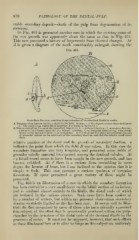Page 860 - My FlipBook
P. 860
870 PATHOLOGY OF THE DENTAL PULP.
erable secondary deposit—death of the pulp from degeneration of its
structure.
In Fig. 465 is presented another case in which the exciting cause of
the new growth was apparently about the same as that in Fig. 464.
This case presented a history of hypersemia from thermal changes. At
A is given a diagram of the tooth considerably enlarged, showing the
Fig. 465.
Secondary Deutine, resulting from irritation of the dentinal fibrils by caries.
A, Diagram of an incisor having a decay in the labial surface, a, and a deposit of secondary dentine at
h. The point from which the illustration B is taken is sliown by c.
B, Illustration of the Tissue of the Secondary Deposit in A : a, primary dentine ; h. secondary dentine ;
c seems to be a blood-vessel that has become calcified ; d, an irregular fault having some resem-
blance to the lacunse of bone : e, pulp-chamber. It will be noted tliat there are irregular deposits
of granular matter in the substance of the secondary dentine, and that the tubules wind about
them.
relative position of the decay and the growth of secondary dentine, c
indicates the point from which the field B was taken. In this case the
secondary formation was very irregular, and presented many fields of
granular calcific material interspersed among the dentinal tubules. At
c a blood-vessel seems to have been caught in the new growth, and has
become calcified. At d there is a curious form resembling in some
degree the lacunse of bone, but I am inclined to the opinion that it is
simply a fault. This case presents a curious specimen of irregular
formation. If space permitted a great variety of these might be
presented.
Fig. 466 is an illustration of a ca.se in which the seondary formation
has been excited by a very small decay on the labial surface of an incisor,
and is confined almost entirely to the fibrils, the distal ends of which
are irritated by the carious process. Such cases have been spoken of
by a number of writers, but within my personal observation secondary
dentine so strictly limited as this has been rare. It serves well to illus-
trate the fact recognized by most of those who have critically examined
this subject, of the effect that is occasionally produced within the pulp-
chamber by the irritation of the distal ends of the dentinal fibrils by the
processes of caries. It must not be supposed, however, that such effects
as those illustrated here or in other writings on this subject are uniformly


